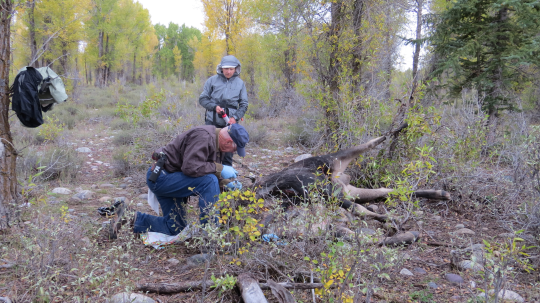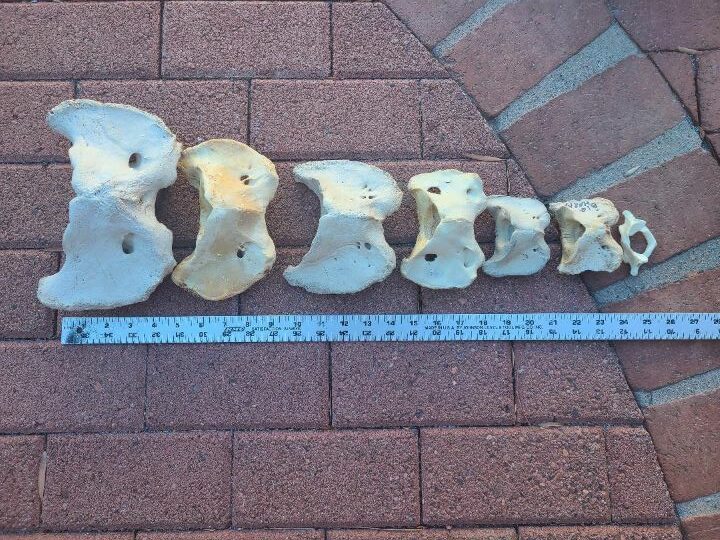“We have seven vertebrae in our necks,” I would tell my grade school tours when I was a docent leading them around the Denver Zoo years ago. I even showed them a replica of the first vertebra in a human neck, much the size of an onion ring.
How Many in a Giraffe?
As we then stood in front of the giraffe exhibit, I would ask, “How many vertebrae does a giraffe have in its neck?” Answers ranged from hundreds to thousands. Then I would reveal a characteristic of mammals that’s not usually mentioned. “All mammals, with three exceptions, have seven vertebrae in their necks!”
Staring at the giraffe’s neck, the young students found it difficult to imagine only seven vertebrae in the giraffe’s neck until I held up a string of cardboard cutouts showing how each vertebra was about the size of an average adult shoe.

The Collection of the Atlas
Since then, I have collected the first neck vertebra (the atlas) of many different mammal species, some harvested from roadkill or other deaths. Comparing the atlas of a bighorn sheep to a human atlas, I can demonstrate how a bighorn can hold up two 7-pound horns on its head because their neck vertebrae are so much beefier than ours and allow for more muscle attachment.

When doing programs, even now I ask visitors how many neck vertebrae a mammal has so that I can explain how an elk can hold up two heavy antlers or a bison can lift its massive head. I receive answers from adults as well as children that range from twenty to hundreds (even thousands) of neck vertebrae after I first show them the human atlas. Most who answer correctly are in the medical or biological or wildlife fields.
Discovery
But recently I discovered that there are other ways to learn the answer to the number of neck vertebrae in a mammal besides earning a degree in one of those subjects. The other day, representing Arizona Game & Fish Department, we took our snakes and skulls and antlers and horns to downtown Phoenix to a Halloween event sponsored by Phoenix police and Salvation Army. Once again, I used my collection of neck vertebrae to explain how the desert bighorn can hold two heavy horns on its head. When I asked one man how many neck vertebrae we humans have, he answered immediately, “Seven!”
Astonished, I asked, “Are you in the medical field?”
“No,” he replied. “But last summer I learned this fact when I broke my neck!”
(The exceptions to 7 neck vertebrae in mammals: the manatee has 6, the two-toed sloth has 5-7, the three-toed sloth has 8 or 9)



Once again, I enjoyed your article! I often wondered how the big animals could support those heavy antlers and horns..thanks for the clear explanation! 💙🤗
These animals always seem to have the right tools for the right job! Much better adapted in their neighborhood than the human wimps watching them! Thanks for your comments, Carol!
It’s always fun and educational to get to read your latest! Thanks so much!
Thanks for the comments, Cliff! We really enjoy hearing from our readers. And, we keep learning as well!
Once again, very interesting and full of information I wasn’t fully aware of. I loved both the pictures of the giraffe cutouts and the comparison of various mammals’ atlas. I know all about the 7 vertebra in the neck since I am fused from C-2 to T-1! Thanks for the great article!
Thanks, Jeanne! You learned the facts the HARD way! We appreciate your checking in!
Wow! That was very interesting. I didn’t ever think about how a large animal can hold up its head, let alone a giraffe.
thanks, Caroline! It is amazing how strong other creatures can be. Thanks for your comments!
It’s always wonderful to read your dispatches. I learn so much. Hope you’re both well. When will you lead a hike in Tucson again?
Hello Charmaine, thanks for checking in with us and letting us know you’re still enjoying our articles! We continue to learn new and different ways to further appreciate wildlife and their surroundings.
Check your email for more information regarding your questions.
Take care!
Chuck & Betty
WOW What an interesting and well written article. THANKS, Carol
Hello Carol,
Thanks for your great comments! We, too, enjoy learning and then sharing some of the wonders of nature! And, Sue was a huge influence in our “wild life”
Take care,
Chuck & Betty